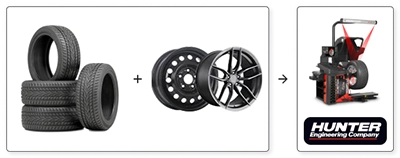The Ultimate Guide: How to Properly Store Your Summer Tires for Winter

As the warm season ends and autumn approaches, it's time to think about storing your summer tires. Many drivers focus on selecting and maintaining their tires during use, but off-season storage is just as crucial. In this article, we will explore why and how to properly store your summer tires, in order to extend their lifespan and ensure optimal performance for the next season.
Proper tire storage is not just about saving space in your garage or shed. It is an essential step in maintaining the integrity of your tires and ensuring your safety on the road. Improperly stored tires can suffer various types of degradation, affecting their performance and, consequently, your driving experience. From preventing rubber degradation to preserving driving characteristics, each aspect of your tire storage deserves special attention.
We will guide you through the best practices for storing your summer tires. Whether you have a dedicated storage space or need to optimize a small area, these tips will help you take care of your tires effectively. Follow these recommendations to ensure that your tires remain in perfect condition and ready to hit the road when summer returns.
Why is it important to store your summer tires properly?
Prevention of Degradation
Tires are designed to withstand various road conditions, but inadequate storage can accelerate their degradation. Exposure to extreme temperatures, moisture, or chemicals can cause cracks in the rubber and alter the internal structure of the tire. For example, a tire stored near solvents, fuels, or lubricants can undergo chemical degradation. Moreover, leaving tires outdoors, under the sun, or in areas where they can accumulate water promotes premature wear. Proper storage should therefore offer a dry, cool environment, sheltered from direct sunlight and chemicals.
Maintenance of Performance
Proper tire storage is essential to maintain their optimal performance. Pressure, balance, and tread integrity are affected if tires are poorly stored. For example, tires stored in a way that they become deformed or under improper pressure can lose their shape, affecting grip and braking ability on the road. Proper storage maintains the original shape of the tire and ensures an even weight distribution when they are mounted back on the vehicle. This ensures that the tires provide consistent driving performance, in terms of road holding and energy efficiency.
Safety
Safety is the most critical aspect of tire maintenance. Well-maintained tires, meaning not only correctly used but also properly stored, reduce the risk of accidents due to tire failures. A well-preserved tread and an intact internal structure ensure better road grip, optimal braking distance, and better responsiveness in turns. Tires that have been exposed to poor storage conditions may have hidden weaknesses, leading to blowouts or loss of control of the vehicle. By taking care to store your tires in ideal conditions, you significantly contribute to the overall safety of your driving.
Steps for Optimal Storage of Summer Tires
Cleaning
Before storing your tires, it is essential to clean them thoroughly. Use water and a mild cleaner to remove dirt, road salt, and debris. Avoid harsh chemicals that could damage the rubber. After cleaning, make sure the tires are completely dry. This process prevents rim corrosion and rubber deterioration, ensuring that your tires remain in good condition during their inactive period.
Inspection
Carefully inspect each tire for signs of wear or damage, such as cuts, cracks, or bulges. Also, check the tread wear. If a tire shows significant damage signs, it may be necessary to replace it. This step is crucial to ensure that the tires are safe and functional for their next use.
Storage Away from Direct Sunlight
Tires should be stored in a cool, dry place, sheltered from the sun's UV rays, which can accelerate the aging of the rubber. A basement, garage, or any other space that is not exposed to direct sunlight or extreme temperatures is ideal.
Positioning
Store the tires vertically, and not stacked on top of each other. Stacking can put excessive pressure on the lower tires, causing deformation. If the tires are mounted on rims, you can hang them on hooks or stack them. In the case of tires without rims, it is better to store them standing up to preserve their shape.
Maintaining Pressure
Before storing them, inflate your tires to the manufacturer's recommended pressure. This prevents the tires from deforming under their own weight during storage. Adequate pressure also ensures they are ready for use when you need them again.
Using Protective Covers
Wrap each tire in a protective cover to protect it from dust, moisture, and temperature variations. Covers specially designed for tires provide additional protection and help maintain ideal storage conditions.
Conclusion
Properly storing your summer tires goes well beyond a simple maintenance routine; it's a crucial investment in the durability of your tires and, more importantly, in your safety on the road. By following the steps we have detailed - from thorough cleaning to using protective covers - you take proactive steps to preserve the integrity and performance of your tires.
This methodical approach ensures that your tires do not suffer premature degradation due to inappropriate storage conditions, such as exposure to UV rays, temperature variations, or deformation under their own weight. A well-maintained tire means safer and more reliable driving. It offers better grip, optimal braking distance, and contributes to a generally more pleasant and safe driving experience.
Moreover, by taking care of your tires, you make long-term savings. Well-maintained tires have a longer lifespan, which means fewer frequent replacements and, consequently, less expense. In short, the time and effort you devote to proper storage of your summer tires translate into increased peace of mind and better performance on the road when you remount them.
In conclusion, remember that storing your summer tires is an essential step in their maintenance. By following these simple yet effective recommendations, you ensure that your tires remain in excellent condition and are ready to offer you optimal performance for the next summer season. Taking care of your tires is taking care of your vehicle, and more importantly, yourself and your passengers.
Dominic Vaillancourt
Automotive expert & Spokesperson


